‘The Color Purple’ Review: Still Here

Alice Walker’s 1982 novel “The Color Purple” has proved tricky to adapt in a manner that retains the book’s power. Part of the problem is it’s an epistolary novel, a genre that’s effective because what characters hide is as revelatory as what they reveal. But letters are exceptionally tricky to transfer to more visual forms, like theater and film. Voice-over can help, but only to a point.
More challenging, though, is the spare and frank tone that Walker imparts to Celie Harris, the woman at the center of the story, who is poor and Black and living in turn-of-the-century Georgia. She writes to God starting in her youth, during which she’s repeatedly raped by the man she believes to be her father, bears two children only to have them taken from her and is forced into a marriage with an abusive man who effectively sees her only as a household slave.
The arc of the story is Celie’s journey toward self-realization and freedom, a theme that pops up across Walker’s work and embodies her perspective on Black women’s liberation, which is as much about race as gender. Last year, she told The New York Times that the term “womanist,” which she coined, is meant not to oppose feminism but to extend it: “It is crucial for Black women to hold on to this very special tradition that we have, exemplified by Harriet Tubman, where you free yourself and you go back and you free other people.”
She might as well have been describing “The Color Purple,” which in addition to Celie is populated by characters at various stages along that journey. Walker won the Pulitzer for her novel, becoming the first Black woman to win the prize for fiction. In 1985, the first big-screen adaptation arrived, starring Whoopi Goldberg, Oprah Winfrey and Danny Glover, and directed by Steven Spielberg. At the time it was criticized for a variety of choices that shifted the story. Celie’s life retained much of its tragedy, but the tone was brightened and Hollywoodified. Quincy Jones’s swelling score feels overbearing and wrong for the tale. Certain elements of the book — such as the romantic, sexual relationship between Celie and her husband’s lover Shug Avery — were curtailed. It’s a movie with some merits, but they’re mostly in the performances.
You might think a musical — not exactly a genre known for its restraint — would be a weird way to take on Walker’s story, and it wasn’t clear from the start it would work. But amid mixed reviews, a florid 2005 original Broadway production, based on both the novel and the film, garnered a pile of Tony nominations (and one win for its star, LaChanze) and played well with audiences. The 2015 revival, a more stripped-down production, earned more critical acclaim and two Tonys.
In 2007, Fantasia Barrino (winner of the third season of “American Idol”) took over from LaChanze in the role of Celie on Broadway. She’s returned to that role for the newest screen adaptation of the show, which has a lineage growing more common in cinema: It’s a movie-musical based on a musical based on a movie based on a book. (Next year’s new “Mean Girls” takes the same route.) Risk-averse studios are always searching for surefire hits, and what’s more surefire than something that’s already been successful?
This version, directed by Blitz Bazawule and produced by many people who’ve been involved along the way (including Spielberg, Winfrey, Jones and the Broadway show’s producer Scott Sanders), is certainly poised for success. In addition to Barrino, the cast has the incredible Danielle Brooks reprising her role as Sofia from the Broadway revival, Colman Domingo, Corey Hawkins, Aunjanue Ellis-Taylor, the singers H.E.R. and Ciara, and Taraji P. Henson as Shug Avery, a role she seems born to play.
There’s a lot to like about this “Color Purple,” which is more inspired by the musical than a straight adaptation of it. Some songs from the show have disappeared; others have been added, and “Miss Celie’s Blues (Sister),” from the 1985 film, even shows up. Marcus Gardley’s screenplay in some ways hews closer to the book — specifically in the romance between Shug and Celie, which is far from explicit but is obviously intimate. That’s an important layer in Celie’s life. If “The Color Purple” is a story about an abused Black woman learning her worth in the company of other women, then Celie’s relationship with Shug, which shows her what it means to feel pleasure and safety, is a key component in her evolution.
Even better, for the first two hours, it’s absorbing: big song-and-dance numbers and emotional set pieces, dynamic performances from everyone, and a feeling of reverence for the story and what it’s meant for 40 years give it gravitas and heart. I found myself wishing (as I often do with contemporary movie-musicals) that the editing would slow down and let me actually watch the dancers. But on the whole, I was gripped.
Yet by the end it’s clear that the story remains slippery to would-be adapters. This iteration encounters the same issue that Spielberg’s version did: to really tell Celie’s story, you have to allow space for some unutterable atrocities that give heft to her later development into a woman of determination and courage. And in an average movie running time, characters tend to get flattened down to caricatures; while this adaptation at least gives the men a little more humanity than previous versions, they still come off as basically soulless monsters. Hollywood movies are ill-suited to this kind of material, and the whole thing inevitably suffers as a result.
I assume that’s what happened in the last half-hour or so, when Celie’s story suddenly rushes headlong to an end. It’s a happy end, but one that feels mismatched rhythmically with the rest of the film. Sudden changes of heart seem unmotivated, which drains the final scene of its power.
It’s too bad, and I hope some future adaptation of Walker’s novel gets Celie’s expansive humanity right. There’s so much fertile ground left to explore. It’s a tale of horror, but also of heroism — a Black woman who finds freedom in the company of other Black women, and then, with incredible bravery, extends that freedom onward.
The Color Purple
Rated PG-13 for incest, rape, racism and abuse. Running time: 2 hours 20 minutes. In theaters.




